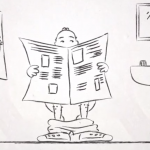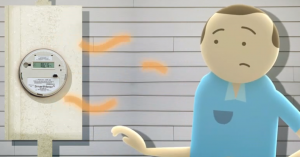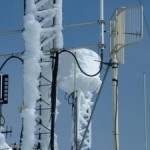The Smart Grid Consumer Collaborative (SGCC), an industry group, has published a video “Separating the Facts from the Fiction about Smart Meter”. PG&E, SCE, SDG&E, BC Hydro, PEPCO, BGE, FPL, other utility companies and Smart Meter manufacturers like Landis and Gyr, Itron, Silver Springs Network, GE, Aclara, are SGCC members. Affiliate members are utility regulators including Public Utility Commissions from California, Colorado, Texas, and including big environmental groups like EDF and NRDC.
This video attempts to counter legitimate Smart Meter complaints and serious problems. They start by saying there’s misinformation about Smart Meters floating about the internet (displaying a panic button) and they plan to set the record straight. “Let’s get down to business” is a key introductory phrase. Promoting Smart Meters IS their business.
- Industry fiction: Smart Meters don’t know how you’re using power

- FACT: Smart Meters “…can be used to pinpoint the use of most major household appliances. Such detailed information about the in-home activities of electricity customers can thus be used to piece together a fairly detailed picture of an individual’s daily life or routine.”
- Industry fiction: “Most of the time your meter is idle”
- FACT: One PG&E Smart Meter can transmit up to 190,000 pulses a day. PG&E’s Big Confession
- Industry fiction: “Your power company has kept your data private for decades.”
- FACT: PG&E released names, email addresses and private online conversations they gathered by deception to the media. They redacted PG&E and third party names, and emails and left open customer data, at the same time claiming privacy was a great value to them. PG&E’s spying may cost them
- Industry fiction:”Smart Meters will allow you to make choices that limit your bills.”
- FACT: Over-billing complaints have been reported widely after Smart Meters are installed. Customers in Bakersfield CA were so outraged about overcharging they filed a class action lawsuit against PG&E. See complaints. See also:PG&E admits billing errors, offers scanty refund
- Industry fiction: Science doesn’t support the claim that RF causes cancer

- FACT: The World Health Organization classified RF radiation as a 2b Carcinogen, same as DDT and lead.
- Industry fiction: A household radio transmits RF
- FACT: A household radio receives RF, it is not an RF transmitter.
- Industry fiction: Smart Meters create less exposure to RF radiation than a microwave, cell phone, wi-fi.
- FACT: Daniel Hirsch, a UC researcher, has calculated that smart meters expose you to more than 100 times the full body, cumulative exposure as a cell phone.
- Industry fiction: “Even if you cozied up to a Smart Meter all day, it would require you to snuggle up to one for 375 years before it would equal the exposure of having a daily 15 minute cell phone call over the course of one year.”
- FACT: Smart Meters can exceed FCC safety guidelines (Sage reports)
- FACT: Smart Meters can violate FCC conditions for installment
- Industry fiction: Read the Hobbit instead of worrying that the” Smart Meter is the fourth horseman of the apocalypse that will wreak havoc on your life”
- FACT: Lawsuits are being filed against Smart Meters in several states, California, Maine, Hawaii, Texas, Illinois and more. Utility Regulators in Maryland, Illinois and Pennsylvania are investigating Smart Meter related fires.
Smart Meters are designed to work in a mesh network, transmitting radio frequency (RF) radiation pulses from home to home. If too many customers refuse, the mesh system can fail. Having to provide customers a choice, has become a serious problem for the industry. The industry, with support from regulators are penalizing customers for non-compliance by charging them to opt out. The Smart Grid program which was initiated by the federal government, was designed to be offered, but not forced on customers.
Environmental and activist groups are fighting smart meters in states across the US, Canada, Australia, and England. Join a group in your area.
Initial comments on the video indicate Smart Consumers aren’t buying the industry propaganda:
“The most ridiculous aspect is that they call themselves “Smart Grid Consumer Collaborative” yet they’re 100% INDUSTRY! If you needed iron clad evidence of intent to deceive, I don’t think you could do much better than that.”
“This video reminds me of a video I just watched on youtube titled “Cigarettes are good for you.flv” a must see!”
“Mislabeled as science, this video is the stupidest thing I have heard or seen.”
“Wow, what a bunch of lies! I sure hope people see through this garbage!”
